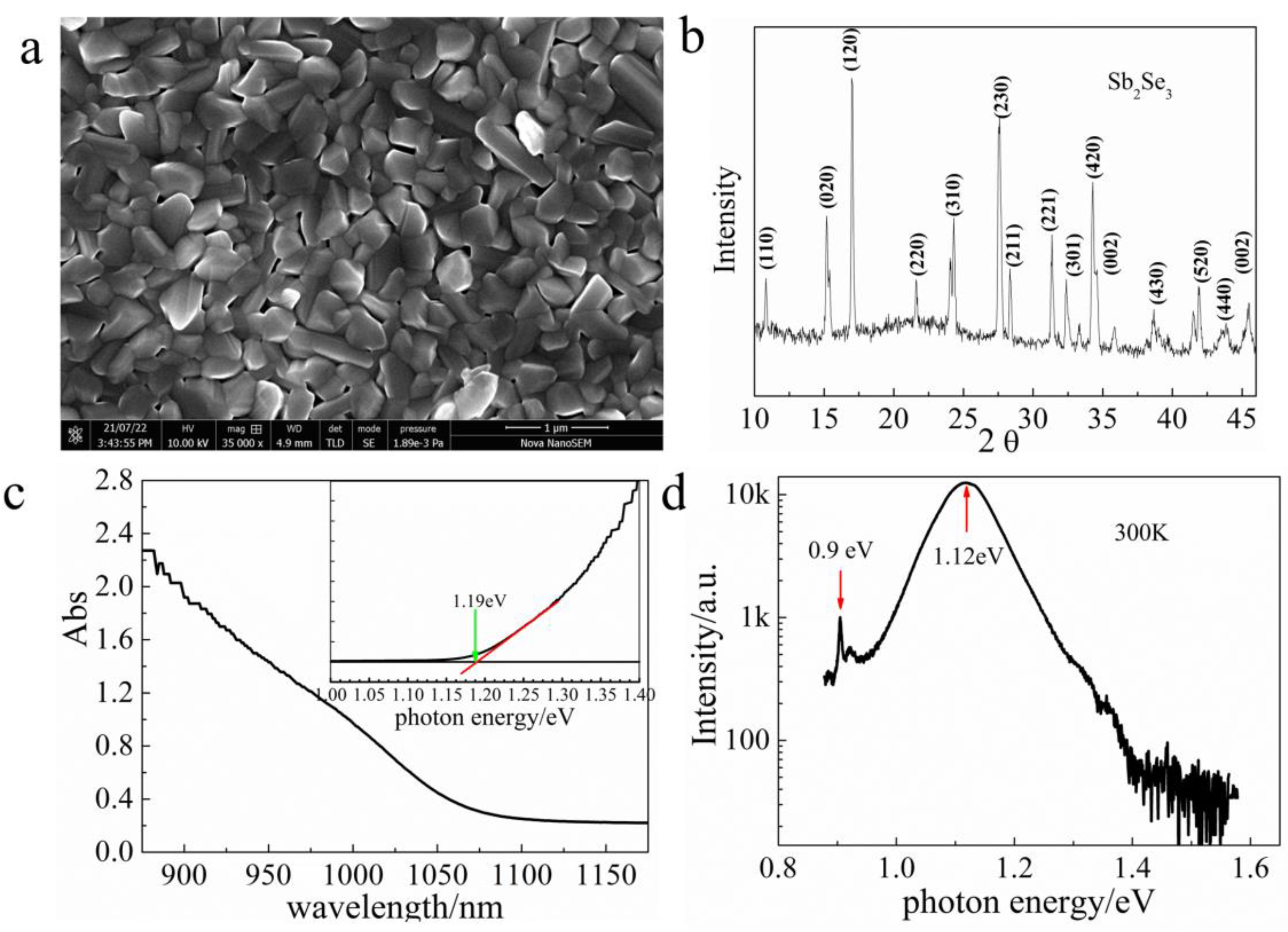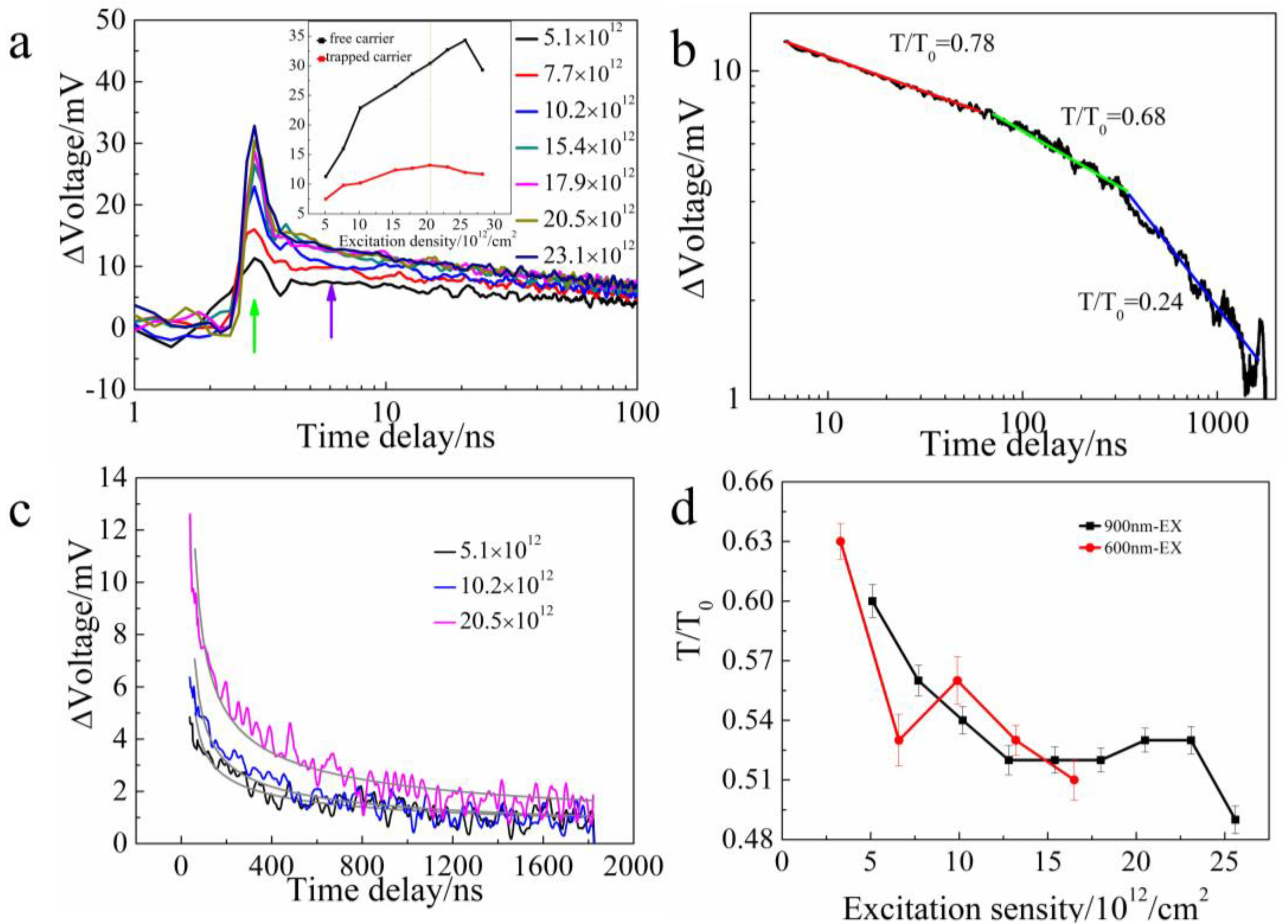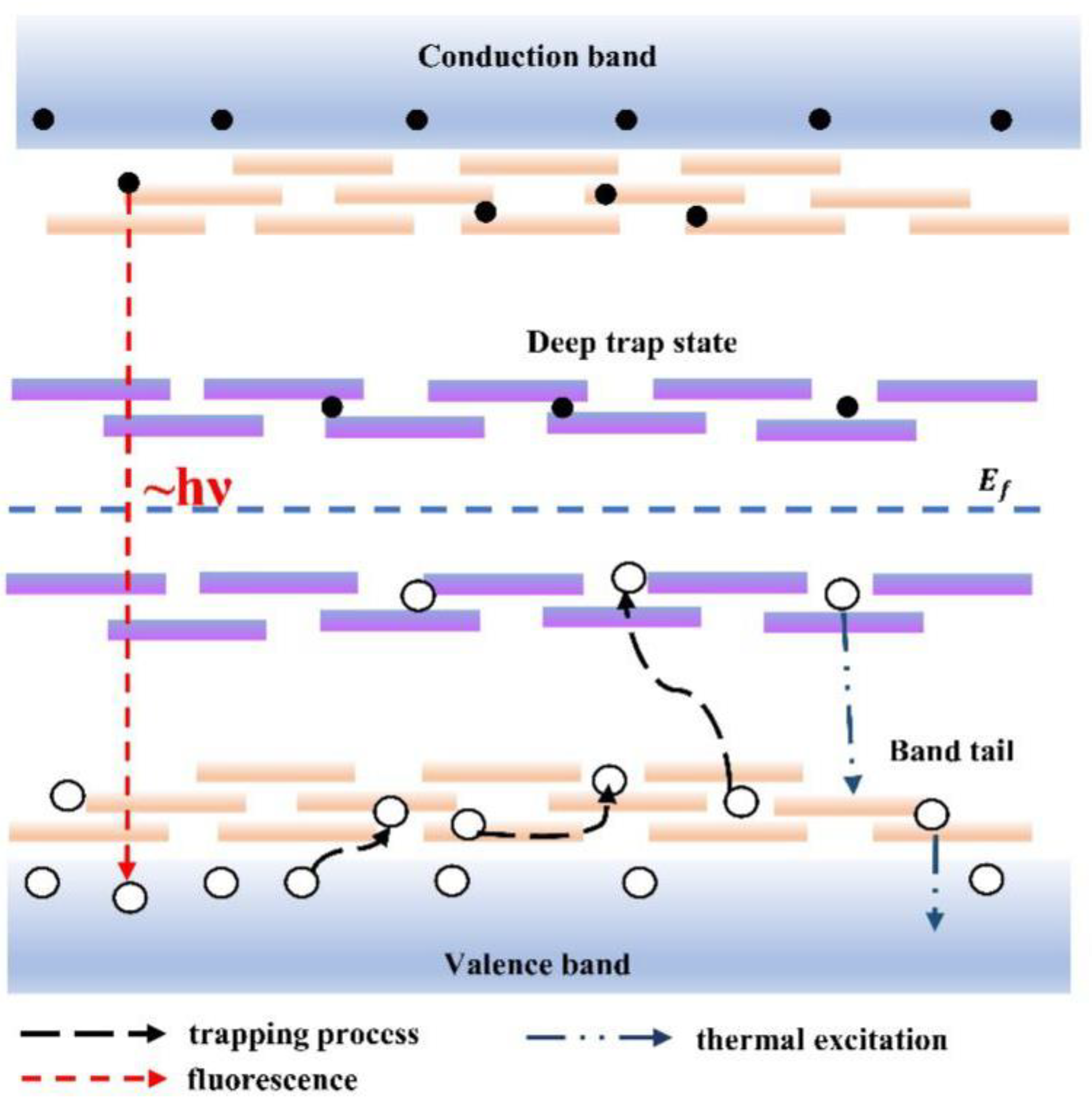Trapped Carrier Recombination in Sb2Se3 Polycrystalline Film
Abstract
:1. Introduction
2. Materials and Methods
2.1. Film Preparation
2.2. Steady-State Photoluminescence Measurement
2.3. Time-Resolved Microwave Conductivity Measurement
2.4. Femtosecond Time-Resolved Reflectivity Measurement
2.5. Structure and Morphology Measurement
3. Results and Discussions
4. Conclusions
Supplementary Materials
Author Contributions
Funding
Conflicts of Interest
References
- Chen, C.; Li, K.; Tang, J. Ten years of Sb2Se3 thin film solar cells. Sol. RRL 2022, 6, 2200094. [Google Scholar] [CrossRef]
- Chen, S.; Liu, T.; Zheng, Z.; Ishaq, M.; Liang, G.; Fan, P.; Chen, T.; Tang, J. Recent progress and perspectives on Sb2Se3-based photocathodes for solar hydrogen production via photoelectrochemical water splitting. J. Energy Chem. 2022, 67, 508–523. [Google Scholar] [CrossRef]
- Müller, M.J.; Yadav, A.; Persch, C.; Wahl, S.; Hoff, F.; Wuttig, M. Tailoring crystallization kinetics of chalcogenides for photonic applications. Adv. Electron. Mater. 2022, 8, 2100974. [Google Scholar] [CrossRef]
- Singh, Y.; Kumar, M.; Yadav, R.; Kumar, A.; Rani, S.; Shashi; Singh, P.; Husale, S.; Singh; V. Enhanced photoconductivity performance of microrod-based Sb2Se3 device. Sol. Energy Mater. Sol. Cells 2022, 243, 111765. [Google Scholar] [CrossRef]
- Wan, P.; Jiang, M.; Su, L.; Xia, S.; Wei, Y.; Xu, T.; Liu, Y.; Shi, D.; Fang, X.; Kan, C. Perpendicularly Reversed Polarization Sensitivity of Double-faced Photodetection based on Sb2Se3 Microbelt. Adv. Funct. Mater. 2022, 32, 2207688. [Google Scholar] [CrossRef]
- Chen, C.; Li, W.; Zhou, Y.; Chen, C.; Luo, M.; Liu, X.; Zeng, K.; Yang, B.; Zhang, C.; Han, J.; et al. Optical properties of amorphous and polycrystalline Sb2Se3 thin films prepared by thermal evaporation. Appl. Phys. Lett. 2015, 107, 043905. [Google Scholar] [CrossRef]
- Chen, C.; Bobela, D.C.; Yang, Y.; Lu, S.; Zeng, K.; Ge, C.; Yang, B.; Gao, L.; Zhao, Y.; Beard, M.; et al. Characterization of basic physical properties of Sb2Se3 and its relevance for photovoltaics. Front. Optoelectron. 2017, 10, 18–30. [Google Scholar] [CrossRef]
- Hadke, S.; Huang, M.; Chen, C.; Tay, Y.F.; Chen, S.; Tang, J.; Wong, L. Emerging chalcogenide thin films for solar energy harvesting devices. Chem. Rev. 2021, 122, 10170–10265. [Google Scholar] [CrossRef]
- Chen, T.; Cao, R.; Cai, H.; Lian, W.; Tang, R.; Xiang, Y.; Wang, Y. Revealing the chemical structure-dependent carrier trapping in one-dimensional antimony selenide photovoltaic materials. J. Mater. Chem. A 2022, 10, 20482–20488. [Google Scholar] [CrossRef]
- Grad, L.; von Rohr, F.; Zhao, J.; Hengsberger, M.; Osterwalder, J. Photoexcited charge carrier dynamics in Sb 2 Se 3 (100). Phys. Rev. Mater. 2020, 4, 105404. [Google Scholar] [CrossRef]
- Wang, K.; Chen, C.; Liao, H.; Wang, S.; Tang, J.; Beard, M.C.; Yang, Y. Both free and trapped carriers contribute to photocurrent of Sb2Se3 solar cells. J. Phys. Chem. Lett. 2019, 10, 4881–4887. [Google Scholar] [CrossRef]
- Yang, Z.; Wang, X.; Chen, Y.; Zheng, Z.; Chen, Z.; Xu, W.; Liu, W.; Yang, Y.; Zhao, J.; Chen, T.; et al. Ultrafast self-trapping of photoexcited carriers sets the upper limit on antimony trisulfide photovoltaic devices. Nat. Commun. 2019, 10, 4540. [Google Scholar] [CrossRef] [PubMed] [Green Version]
- Tao, W.; Zhu, L.; Li, K.; Chen, C.; Chen, Y.; Li, Y.; Li, X.; Tang, J.; Shang, H.; Zhu, H. Coupled Electronic and Anharmonic Structural Dynamics for Carrier Self-Trapping in Photovoltaic Antimony Chalcogenides. Adv. Sci. 2022, 9, 2202154. [Google Scholar] [CrossRef]
- Lian, W.; Cao, R.; Li, G.; Cai, H.; Cai, Z.; Tang, R.; Zhu, C.; Yang, S.; Chen, T. Distinctive Deep-Level Defects in Non-Stoichiometric Sb2Se3 Photovoltaic Materials. Adv. Sci. 2022, 9, 2105268. [Google Scholar] [CrossRef] [PubMed]
- Huang, M.; Xu, P.; Han, D.; Tang, J.; Chen, S. Complicated and unconventional defect properties of the quasi-one-dimensional photovoltaic semiconductor Sb2Se3. ACS Appl. Mater. Interfaces 2019, 11, 15564–15572. [Google Scholar] [CrossRef] [PubMed]
- Prabhakar, R.R.; Moehl, T.; Friedrich, D.; Kunst, M.; Shukla, S.; Adeleye, D.; Damle, V.H.; Siol, S.; Cui, W.; Gouda, L.; et al. Sulfur treatment passivates bulk defects in Sb2Se3 photocathodes for water splitting. Adv. Funct. Mater. 2022, 32, 2112184. [Google Scholar] [CrossRef]
- Prabhakar, R.R.; Moehl, T.; Friedrich, D.; Kunst, M.; Shukla, S.; Adeleye, D.; Damle, V.H.; Siol, S.; Cui, W.; Gouda, L. Gouda, Unravelling Defect Passivation Mechanisms in Sulfur-Treated Sb2Se3; Cambridge University Press: Cambridge, UK, 2021. [Google Scholar] [CrossRef]
- Duan, Z.; Liang, X.; Feng, Y.; Ma, H.; Liang, B.; Wang, Y.; Luo, S.; Wang, S.; Schropp, R.E.I.; Mai, Y.; et al. Sb2Se3 Thin-Film Solar Cells Exceeding 10% Power Conversion Efficiency Enabled by Injection Vapor Deposition Technology. Adv. Mater. 2022, 34, 2202969. [Google Scholar] [CrossRef] [PubMed]
- Xiao, Z.; Tao, T.; Shu, J.; Dang, W.; Pan, S.; Zhang, W. Charge Carrier Recombination Dynamics in MAPb (Br1−yIy) 3 Single Crystals. Crystals 2022, 12, 1425. [Google Scholar] [CrossRef]
- Yang, W.; Lee, S.; Kwon, H.-C.; Tan, J.; Lee, H.; Park, J.; Oh, Y.; Choi, H.; Moon, J. Time-resolved observations of photo-generated charge-carrier dynamics in Sb2Se3 photocathodes for photoelectrochemical water splitting. ACS Nano 2018, 12, 11088–11097. [Google Scholar] [CrossRef]
- Orenstein, J.; Kastner, M. Thermalization and recombination in amorphous semiconductors. Solid State Commun. 1981, 40, 85–89. [Google Scholar] [CrossRef]
- Piana, G.M.; Bailey, C.G.; Lagoudakis, P.G. Phonon-Assisted Trapping and Re-excitation of Free Carriers and Excitons in Lead Halide Perovskites. J. Phys. Chem. C 2019, 123, 19429–19436. [Google Scholar] [CrossRef]
- Williams, C. Kinetics of trapping, detrapping, and trap generation. J. Electron. Mater. 1992, 21, 711–720. [Google Scholar] [CrossRef]
- Kagawa, T.; Matsumoto, N. Transient photocurrents in a-Si: H and weak electron-phonon coupling processes. Philos. Mag. B 1985, 51, 273–283. [Google Scholar] [CrossRef]
- Birkett, M.; Linhart, W.M.; Stoner, J.; Phillips, L.J.; Durose, K.; Alaria, J.; Major, J.D.; Kudrawiec, R.; Veal, T.D. Band gap temperature-dependence of close-space sublimation grown Sb2Se3 by photo-reflectance. Apl. Mater. 2018, 6, 084901. [Google Scholar] [CrossRef] [Green Version]
- Kahmann, S.; Nazarenko, O.; Shao, S.; Hordiichuk, O.; Kepenekian, M.; Even, J.; Kovalenko, M.V.; Blake, G.R.; Loi, M.A. Negative thermal quenching in FASnI3 perovskite single crystals and thin films. ACS Energy Lett. 2020, 5, 2512–2519. [Google Scholar] [CrossRef]
- Watanabe, M.; Sakai, M.; Shibata, H.; Satou, C.; Satou, S.; Shibayama, T.; Tampo, H.; Yamada, A.; Matsubara, K.; Sakurai, K.; et al. Negative thermal quenching of photoluminescence in ZnO. Phys. B Condens. Matter 2006, 376, 711–714. [Google Scholar] [CrossRef]
- Shibata, H. Negative thermal quenching curves in photoluminescence of solids. Jpn. J. Appl. Phys. 1998, 37, 550. [Google Scholar] [CrossRef]
- Singh, P.; Ghorai, N.; Thakur, A.; Ghosh, H.N. Temperature-dependent ultrafast charge carrier dynamics in amorphous and crystalline Sb2Se3 Thin Films. J. Phys. Chem. C 2021, 125, 5197−5206. [Google Scholar] [CrossRef]
- Savory, C.N.; Scanlon, D.O. The complex defect chemistry of antimony selenide. J. Mater. Chem. A 2019, 7, 10739–10744. [Google Scholar] [CrossRef] [Green Version]
- Liu, X.; Xiao, X.; Yang, Y.; Xue, D.-J.; Li, D.-B.; Chen, C.; Lu, S.; Gao, L.; He, Y.; Beard, M.C.; et al. Enhanced Sb2Se3 solar cell performance through theory-guided defect control. Prog. Photovolt. Res. Appl. 2017, 25, 861–870. [Google Scholar] [CrossRef]
- Cifuentes, N.; Ghosh, S.; Shongolova, A.; Correia, M.R.; Salomé, P.M.P.; Fernandes, P.A.; Ranjbar, S.; Garud, S.; Vermang, B.; Ribeiro, G.M.; et al. Electronic conduction mechanisms and defects in polycrystalline antimony selenide. J. Phys. Chem. C 2020, 124, 7677–7682. [Google Scholar] [CrossRef]
- González, J.C.; Limborço, H.; Ribeiro-Andrade, R.; Silva, B.C.; Krambrock, K. Deciphering the role of defects in the ambipolar electrical transport in nanocrystalline Sb2Se3 thin films. Adv. Electron. Mater. 2022, 8, 2100985. [Google Scholar] [CrossRef]
- Dong, S.; Sun, L.; Yue, F. Influence of selenium growth condition on the photovoltaic conversion efficiency of Sb2Se3 as the solar cell absorption layer. J. Mater. Sci. Mater. Electron. 2022, 33, 10335–10342. [Google Scholar] [CrossRef]




Disclaimer/Publisher’s Note: The statements, opinions and data contained in all publications are solely those of the individual author(s) and contributor(s) and not of MDPI and/or the editor(s). MDPI and/or the editor(s) disclaim responsibility for any injury to people or property resulting from any ideas, methods, instructions or products referred to in the content. |
© 2023 by the authors. Licensee MDPI, Basel, Switzerland. This article is an open access article distributed under the terms and conditions of the Creative Commons Attribution (CC BY) license (https://creativecommons.org/licenses/by/4.0/).
Share and Cite
Tao, T.; Shu, J.; Guo, Y.; Wang, K.; Zhao, X.; Liang, B.; Li, Z.; Dang, W. Trapped Carrier Recombination in Sb2Se3 Polycrystalline Film. Crystals 2023, 13, 406. https://doi.org/10.3390/cryst13030406
Tao T, Shu J, Guo Y, Wang K, Zhao X, Liang B, Li Z, Dang W. Trapped Carrier Recombination in Sb2Se3 Polycrystalline Film. Crystals. 2023; 13(3):406. https://doi.org/10.3390/cryst13030406
Chicago/Turabian StyleTao, Tingting, Jingting Shu, Yingnan Guo, Kai Wang, Xiaohui Zhao, Baolai Liang, Zhiqiang Li, and Wei Dang. 2023. "Trapped Carrier Recombination in Sb2Se3 Polycrystalline Film" Crystals 13, no. 3: 406. https://doi.org/10.3390/cryst13030406





